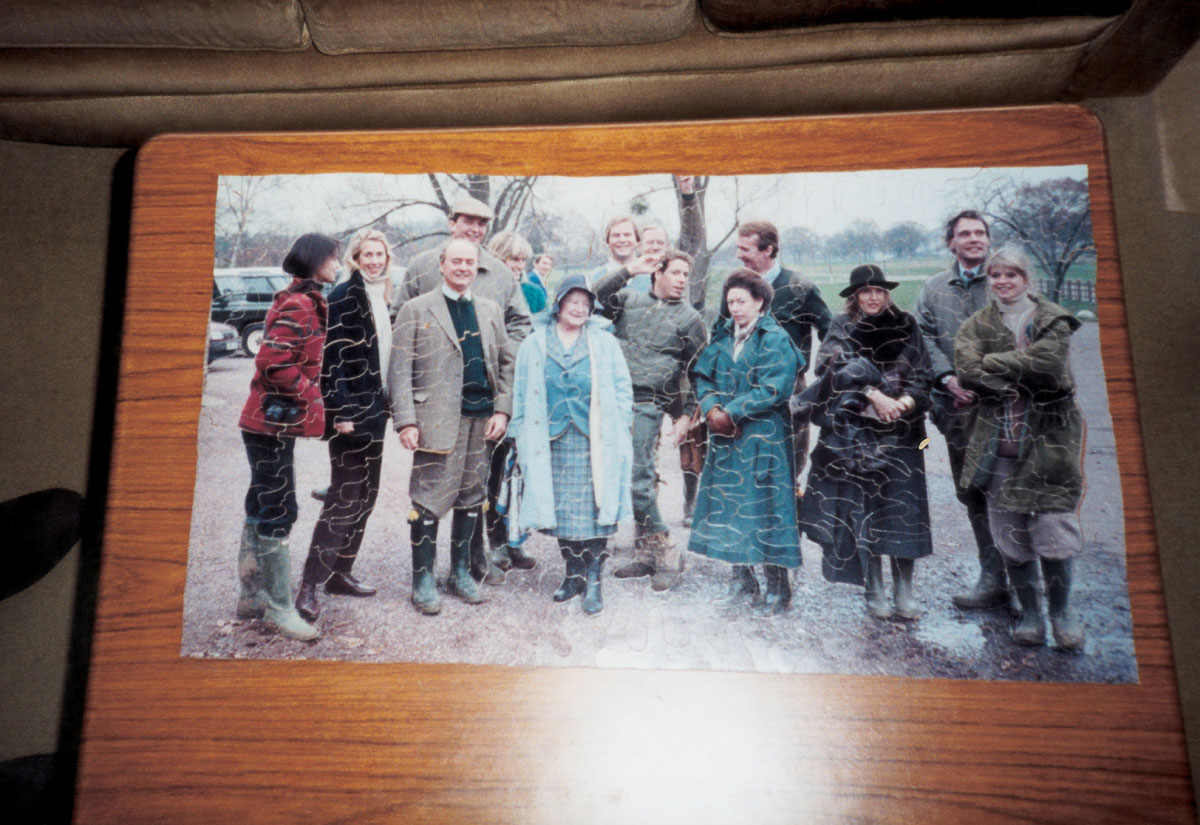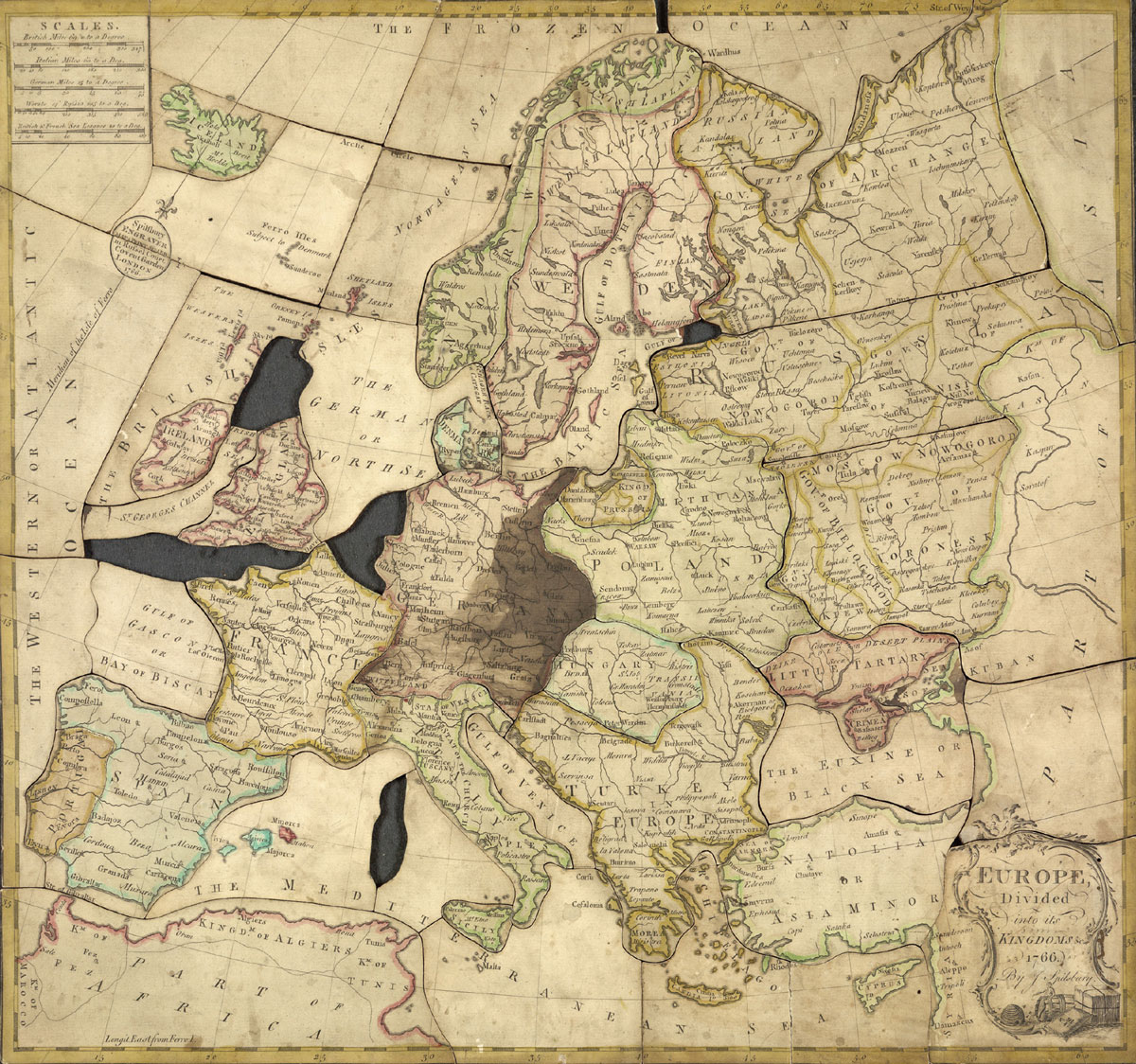Jigsaws: A User’s Manual
Assembling a history of the puzzle
Christopher Turner
My grandfather, Dick Sawbridge, once appeared on a TV game show called “What’s My Line?” in which a panel of celebrities had to work out what his hobby was by asking him indirect questions. They never guessed it.
He cut puzzles for the British Jigsaw Library. Established in 1932, the Library was one of the last organizations to create traditional, handmade wooden jigsaws, considered the Rolls Royce of the form. My grandfather was an eccentric engineer who had worked on tea plantations in colonial India and took up puzzling when he retired in 1970. He created many puzzles for the Queen. I remember two of the private commissions he made Her Majesty: a collage of the royal corgis, assembled by her ladies-in-waiting; and what looks like a royal shooting party.

My grandfather wouldn’t let me take a photograph of the former, in case the developer leaked it to a tabloid. I did anyway, and my mother took a picture of the latter. It would probably have been pieced together over Christmas at Balmoral Castle, and it shows a rare and intimate glimpse of the royal family as they’d like to see themselves. (Viscount Linley, the Queen’s nephew, who is himself a carpenter, is the man camping it up behind the Queen Mother and Princess Anne.) The puzzle was made at their behest, of course. But in a country where defiling the portrait of the Queen on a postage stamp is considered criminal, it almost seems a republican gesture to chop the ruling clan into a thousand pieces and jumble them up. I remember my grandfather hunched over his treadle blade, cutting wood into infuriating shapes, which my grandmother would reassemble to check that no piece was missing before boxing them up. (If one was lost, he’d cut a duplicate that she’d paint to fill the void). Each jigsaw would take about a week to make. He’d sit for hours peddling away—the machine was foot-operated—with a blanket over his legs to keep him warm and to catch the sawdust. Eventually, however, he went blind (might the dust have played a part?) and he had to give up. As he sightlessly navigated his house, I often imagined him negotiating it like a puzzle, each step a piece making up the whole picture he’d lost.


In Life: A User’s Manual (1978), Georges Perec takes jigsaws as a theme and structural motif. His central character, a wealthy Englishman named Percival Bartlebooth, turns jigsaws—in French, casse-têtes, “head breakers” or “brain teasers”—into a lifelong art. Bartlebooth spends 10 years learning how to paint and 20 years traveling the world doing so, painting 500 watercolors of the seaports he visits. He sends these back to Paris to be made into jigsaws, and the final 10 years of his life are spent reassembling the puzzles. When one is completed, he glues it back together and “retexturizes” the image to hide the cuts. He then returns the pictures to the places where they were painted, and immerses the seascapes in saltwater, which eats away the image and restores the paper to its original, pristine state of blankness. Only the watermark remains.
As Perec implies, there is something futile about jigsaws. One carves an image up only so that someone else may slowly reassemble it. Bartlebooth makes a career of pointless self-iconoclasm. But he doesn’t quite achieve his goal of turning his existence into an act of gratuitous circularity. He dies with the last piece of the 439th puzzle in his hand. It looks like a W, but the single missing piece of the puzzle should be an almost perfect X. The message seems to be that things don’t necessarily fit, that life is not so tidily resolvable. But X marks the spot of a clue as well as a lesson. Perec’s novels, as Paul Auster has noted, are “studded with intellectual traps, allusions and secret systems,” and the extraneous W refers us to an earlier book, which takes that letter as its title. It is a memoir of Perec’s childhood, interspersed with a tale about two Gaspard Wincklers—which turns out to be the name of the jigsaw cutter Percival Bartlebooth employs to make fragmented mysteries of his paintings.
Doing a jigsaw, like reading Perec’s novels, is a form of detective work. (It is no accident that Sir Arthur Conan Doyle was on the board of directors of Tuck Puzzles, manufacturers of the “Zag-Zaw.”) Puzzling, like reading, is never a solitary art, but a duel, like chess: “Every move the puzzler makes, the puzzle maker has made before,” Perec writes, “every piece the puzzler picks up, and picks up again, and studies and strokes, every combination he tries, and tries a second time, every blunder and every insight, each hope and each discouragement have all been designed, calculated, and decided by the other.” When my grandmother, the Queen, or anyone else, pieces together my grandfather’s puzzles, he has anticipated them, outwitting them at every turn; rounding or scalloping the corners, creating identically shaped pieces and “false edges” (as internal straight edges are called), or cutting along the colour lines to create visual red-herrings. “The art of jigsaw puzzling,” Perec continues, “begins with a wooden puzzle cut by hand, whose maker undertakes to ask himself all the questions the player will have to solve, and, instead of allowing chance to cover his tracks, aims to replace it with cunning, trickery, and subterfuge.”
In a way, my grandfather’s puzzles were made specifically for his wife, who was the first to complete them, and there is something tortuous in the way he would cut up pictures into crazy shapes for her to reassemble. Unlike the easy commercial cardboard puzzles with their interlocking pieces which neatly click into place—“eschewed by the true puzzle lover,” according to Perec—his wooden puzzles were “push-fit” and slid around. They never had a picture of the finished image on the box, which he felt would spoil the challenge and suspense, and were crammed full of his quirky idiosyncrasies. He would include dexterous silhouette-shaped tiles, or “whimsies,” depicting animals, birds, or the occasional letter, which when read together would form a word or clue. Perhaps only my grandmother was able to decode the secret messages that some of these rebuses contained.
• • •

In about 1760, John Spilsbury, a London engraver and mapmaker, invented the world’s first jigsaw puzzle. He mounted one of his maps of Europe on a wooden board and carefully cut around the borders of each of its kingdoms. The simple “dissection,” as jigsaws were then called, was intended to teach children their geography. (In a rare surviving example of his handiwork, Prussia, Corsica, and Naples are missing.) Spilsbury’s invention caught on, and at first all jigsaws were pedagogical aids—cut-up maps, genealogies, mathematical tables, scenes from Bible stories, and nursery rhymes—with titles like Ladder of Learning, Moral Pictures, and The Hill of Science: An Allegory.
Jigsaw puzzles for adults (known as “Whatami”—What-am-I?) finally emerged around 1900 and became a full-blown craze in America in 1908, before spreading to Europe. In 1910, the trade magazine Toys and Novelties reported from Paris that, “the ‘cut-up puzzle’ came on a wave of contagion from America and is now an obsession in the capital and has replaced bridge and whist as evening entertainment.” Such popularity notwithstanding, the time required to cut a wooden jigsaw by hand with a jig-saw remained considerable, so that a 500-piece puzzle cost about $5 in 1908, an amount well beyond the means of the average worker. The activity remained essentially a form of aristocratic leisure, the pastime of weekend house parties, as it still is for the Queen.
Nevertheless, the golden age of jigsaw puzzles coincided with the Great Depression, when mass production and inexpensive cardboard allowed the manufacturers to cut prices substantially, offering a time-consuming and inexpensive home amusement. The puzzles were die-cut, using a machine which resembled a giant cookie-cutter that punched the puzzles in an artless and arbitrary fashion. These were given away as advertisements, sold in American drugstores—the die-cut “Jig of the Week” retailed for 25 cents —and circulated by libraries, who charged three to ten cents per day for their rental, depending on the size. In early 1933, as the economy touched a nadir, sales of jigsaws in the US reached a staggering ten million a week.
After World War II, the expensive, traditional wooden jigsaw went into decline, and even its cheap cardboard rival slumped in popularity. Maybe the world —the subject of the first jigsaws—was fragmented enough in itself, or maybe piecing it neatly back together seemed impossible. Today, only a few places, like the British Jigsaw Library, which still circulates many of my grandfather’s unique puzzles, keep this dying art alive.
My mother recently took out one of my grandfather’s jigsaws. My grandmother had just passed away, and in piecing the puzzle back together, my mother was following the trail of both her parents: the father who’d deviously cut it, and the mother who’d patiently put it back together. It seemed a nice metaphor for mourning, and we sat for hours quietly bringing the kaleidoscopic picture into focus once again. It turned out to be a still-life complete with memento mori. “Anyone seen this piece,” my mother asked, pointing to an irregular, final gap. “The one shaped like a little coffin?”

Christopher Turner is writing a book, Adventures in the Orgasmatron: How the Sexual Revolution Came to America, to be published by Farrar, Straus and Giroux. He is an editor of Cabinet.
Spotted an error? Email us at corrections at cabinetmagazine dot org.
If you’ve enjoyed the free articles that we offer on our site, please consider subscribing to our nonprofit magazine. You get twelve online issues and unlimited access to all our archives.